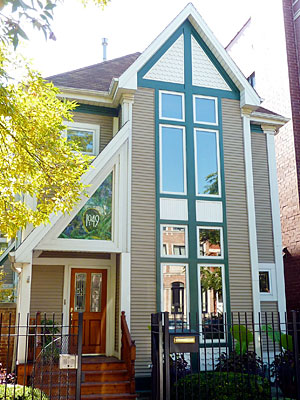
Former home of John Cusack. See last paragraph below.
In Chicago, Milwaukee, Detroit and Indianapolis, the rate of homes going into foreclosure is about the same. But according to a new study by analysts at the Federal Reserve Bank of Chicago, distressed homes here stay in foreclosure longer than they do in those other markets—which means they are likely to drag down our local housing market longer than the distressed homes in those other cities.
In their article, “What is the Foreclosure Rate?”, analysts from the Fed’s community development and policy studies group looked at the foreclosure rates in June in five major Midwestern metro areas. (Des Moines/Polk County, Iowa was also on the list, but its foreclosure rate is well below the rest of the pack.) They found that in the home counties of the four big cities, the pace of homes exiting foreclosure through a sale, a loan modification, or some other settlement was markedly slower in Cook County than in the other regions, even though the rate of homes going into foreclosure ran about the same.
In June, 5 percent of Cook County foreclosures “transitioned,” as the report puts it; in Indianapolis/Marion County, the figure was 7.8 percent; in Milwaukee City/County, it was 10 percent; and in Detroit/Wayne County, it was 20.7 percent—better than four times the rate here. “The slow transition rate is a big factor in why [Cook County’s] foreclosure rate looks so high,” said Emily Engle Rotenberg, one of the study’s authors. “We want to see people focusing their attention on that aspect of the problem.”
Earlier this year, the Chicago News Coop reported that Chicago has the nation’s biggest backlog of unsold foreclosures, with the implication that, until all that inventory clears, home prices will remain suppressed. This Fed report suggests that our region may have even more trouble ahead, given that most forecasters say that there are additional foreclosures in the pipeline. If foreclosures are slower to process and transition here than in other parts of the Midwest, then the Chicago housing market could take longer to recover, which could diminish the city’s desirability.
“Even when people aren’t going into foreclosure [at the same high rate] anymore, there will still be an inventory of foreclosures,” said Robin Newberger, a member of the research team. “It extends the path to recovery,” added her colleague Daniel DiFranco. “It will take longer for the market to find its true bottom,” which is necessary before a sustainable upturn can begin.
The researchers are still looking into the factors in Chicago’s slower foreclosure process, but they cite bank policies, the availability of mediation, and housing prices (we’re more expensive) as contributing to the delay. They will post their study soon, and I’ll link to it here.
Also: John Cusack sold his house September 15—but it wasn’t the movie star John Cusack. This Cusack, a real-estate lawyer at DLA Piper, sold the 12-room Lincoln Park house where he had lived since 1994 for $1.85 million, down from his $2 million asking price. He did not respond to a request for comment on whether, during the 17 years he lived in the home, fans ever stood outside his house in trench coats holding boom boxes above their heads.


